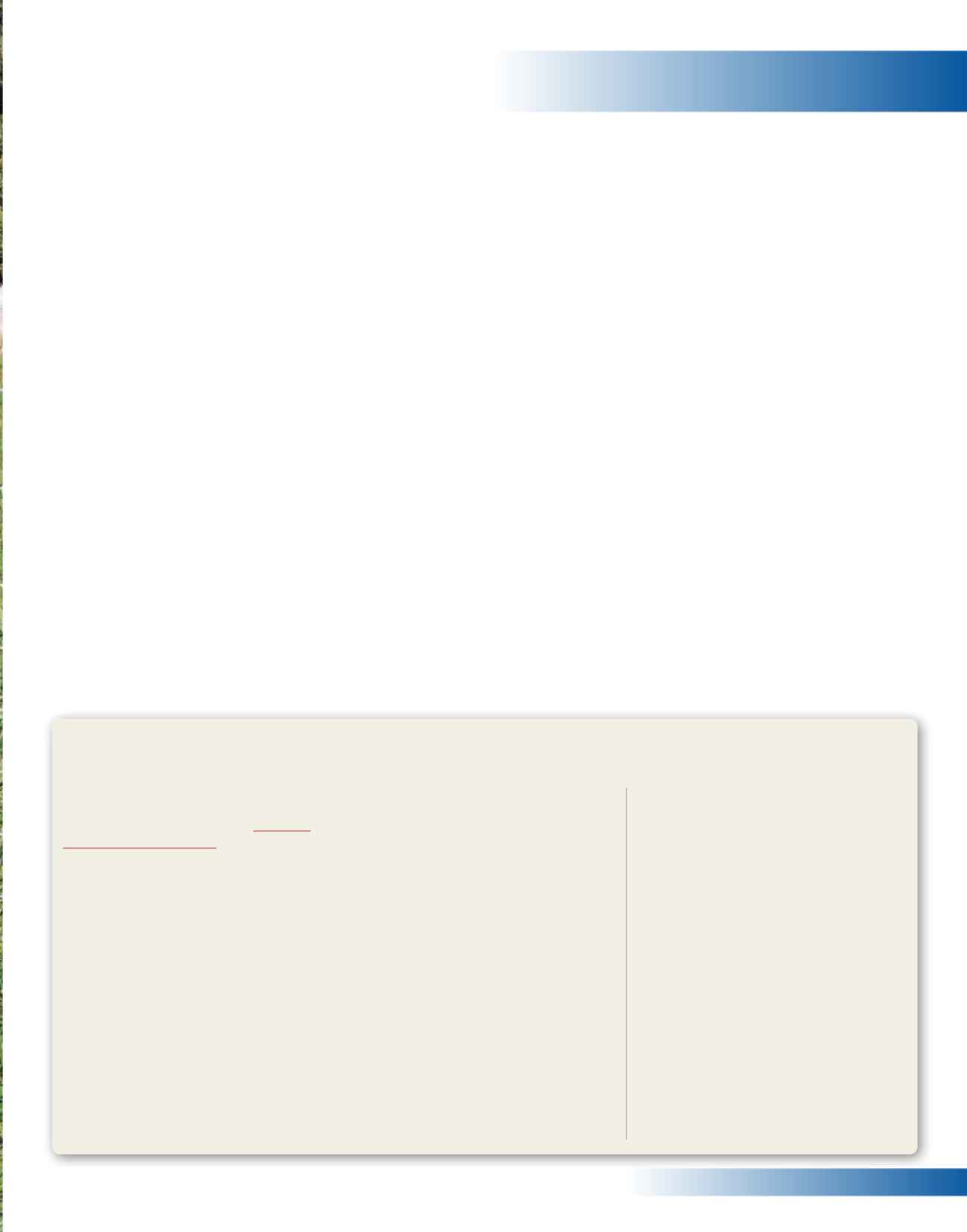
The size of the pulse that travels from
an energizer’s fence terminal varies in
volts and joules
according to the sum
total of the resistances in the path
between the two terminals.
These resistances in ohms (
Ω
) include
all of these “numbers”:
a. The resistance of wire/rope/polywire/
tape (100 to 10,000
Ω
/mile).
b. The resistance of the animal at the
point of contact (50 to 2,000
Ω
).
c. The internal resistance of the animal’s
body, hooves, hair (100 to 500
Ω
).
d. Resistance at the point of contact with
the soil (grass, leaves, wet vs dry soil).
e. Resistance of the soil (20 to 50,000
Ω
) if
it’s not a Pos/Neg-wired fence system.
f. The resistance of the ground rod system
and the soil around it.
g. The resistance of weeds (25 to 50,000
Ω
).
It operates in “parallel” with b, c and d.
What’s total fence circuit resistance?
The total circuit resistance of a fence
varies enormously by the hour, day and
week. The key factor is the moisture in the
soil, air, plants and the animal’s nose, hide
and feet. They depend on changes in dew,
rain, type of vegetation, wind, etc.
The only constant is the conductor.
Therefore, the total resistance of a mile
of single-strand, weed-free cattle/deer/
horse fence may vary from 600 to 10,000
Ω
throughout the season. But an extra mile
may add only 10
Ω
to either total (because
the other factors do not change).
The circuit resistance of 1500 ft of weed-
free, temporary electric netting varies
from 200
Ω
to 10,000
Ω
depending on the
soil moisture. Again, adding an extra 1500
ft of ElectroNet may add only 50
Ω
.
A Pos/Neg fence (alternating hot/
ground) is a wise option when the soil and
animal resistances exceed 5,000
Ω
.
1. Impedance type (wide or low)
A simple way to indicate which units are
more capable of responding to challenges
of drier soils, snow-covered soils, and
pushing energy through animals with
high internal electrical resistances (deer,
goats, rabbits, poultry and small sheep).
2. Peak output (in joules)
Guide to an energizer’s ability to cope
with high levels of green vegetation
contacting the energized wire. Higher
numbers are better.
3. Joules at 5000 ohms
The ohms refers to total circuit
resistance (
see below
). Units with larger
numbers can energize more fence when
soil is dry (not arid) or snow-covered.
4. Pulses per minute
More is better. Less time between
pulses means it’s more likely to stop
untrained animals.
5. Battery input
This column describes the battery input
required by each energizer.
6. Fence load LED lights
Not the same as a simple “on” light.
These indicate if voltage and energy levels
are enough to stop most animals. If not lit,
check the fence for problems.
7. Minimum ground rods (ft)
Normal total ground rod requirements.
More may help in certain conditions.
8. Draw in watts/hour
Expected AC draw in watts.
9. High-low output
If there is a switch to reduce output
energy and battery input demand.
10. Battery amp draw per hour on
clean(c) and weedy(w) fences
Expected milliampere (mA) drain from
battery per hour at high output levels for
clean or weed-laden fences.
Predicts size of battery needed (or solar
panel) and how often you will need to
recharge it. Large numbers mean larger
panels or more frequent recharges.
Note that mA draw of Patriot units is
the same for both clean and weedy fences.
For IntelliShock units, when a fence is
clean (no green weeds), the mA draw
is low. If a fence is weedy, the mA draw
of IntelliShock energizers is high. Thus
battery and solar panel requirements
(columns 11 and 12) are higher and lower.
Use Deep Cycle (DC) instead of
automotive batteries. Why? Automotive
batteries can only be drawn down 5%
before they lose recharging ability. DC
batteries can be drawn down 60%. DC
batteries recharge slowly (1 to 2 amp/hr).
Do not go below a 40% charge on a DC
battery whether in use or in storage.
11. Days between recharging for
clean(c) and weedy(w) fences
Predicts when a 12v 100 amp hr deep
cycle battery will need recharging under
clean (no weeds) conditions. Assumes
being drawn down to 40% between
recharges. (An equal size vehicle battery
must be recharged 3X more often to
prevent damage to battery.)
12. Solar panel for clean(c) and
weedy(w) conditions
Predicts solar panel size (in watts)
advised for each energizer under clean vs
weed-laden fence conditions.
The low number of a range assumes 6
average solar insolation hours per day
(southern US or summer in north).
The high number assumes only 4
insolation hours per day. Using a larger
panel allows a smaller battery to be used
and vice versa.
Energizer Chart Data
Explanation of columns and values
of the chart on pp. 100–101.
What is heavy weed load?
Grass growing up to and onto the
conductive strands of the fence (this
drains the pulse strength). Green (moist)
grass drains a fence; brown (dry) does not.
(
Also see p. 13.)
Does the length of the grass stems
reaching the fence make a difference?
A big difference. The longer the stem the
less energy leakage will occur.
Why should I care?
More resistance and weed drain = a
weaker pulse. Livestock and predators
will not be stopped by weak pulses.
Wide-impedance vs low-impedance?
Wide-impedance energizers offer higher
pulse strength when the soil is dry and
grass is brown. Low-impedance units
excel when soil is moist and grass is green.
www.premier1supplies.com• 1-800-282-6631
ENERGIZER CHART DATA 99
Note regarding 10, 11 and 12:
Clean (c)
fences
have no contact with green/wet weeds. Wires in
contact with green
weeds (w)
6" from soil cause
7 times more energy drain than wires contacting
weeds 30" from soil.









